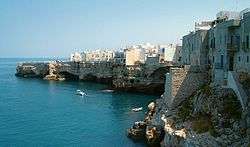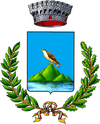Polignano a Mare
| Polignano a Mare | ||
|---|---|---|
| Comune | ||
| Comune di Polignano a Mare | ||
 | ||
| ||
 Polignano a Mare Location of Polignano a Mare in Italy | ||
| Coordinates: 41°00′N 17°13′E / 41.000°N 17.217°E | ||
| Country | Italy | |
| Region | Apulia | |
| Province / Metropolitan city | Bari (BA) | |
| Frazioni | Casello Cavuzzi, Chiesa Nuova, San Vito and a part of Triggianello | |
| Government | ||
| • Mayor | Domenico Vitto | |
| Area | ||
| • Total | 67 km2 (26 sq mi) | |
| Elevation | 24 m (79 ft) | |
| Population (1 January 2016)[1] | ||
| • Total | 18,024 | |
| • Density | 270/km2 (700/sq mi) | |
| Demonym(s) | Polignanesi | |
| Time zone | CET (UTC+1) | |
| • Summer (DST) | CEST (UTC+2) | |
| Postal code | 70044 | |
| Dialing code | 080 | |
| Patron saint | St. Vitus | |
| Saint day | June 15 | |
| Website | Official website | |
Polignano a Mare (Italian: [poliɲˈɲaːno a mˈmaːre]; Peghegnéne [pəɡəɲˈɲeːnə] in Bari dialect) is a town and comune in the Metropolitan City of Bari, Apulia, southern Italy, located on the Adriatic Sea. The local economy mostly depends on tourism, agriculture and fishing.
History
The area has been settled since prehistoric times, evidenced by archaeological excavations in the locality of Santa Barbara. It is believed to be the site of the ancient Greek city of Neapolis of Apulia, not mentioned by any extant records but attested by many coins. Remains of the Roman domination include the bridge on the Via Traiana. The former cathedral includes works by the sculptor Stefano of Putignano. In the frazione of San Vito is a massive Benedictine abbey.
Twin towns
 San Miniato, Italy
San Miniato, Italy Forio, Italy
Forio, Italy
References
External links
 Media related to Polignano a Mare at Wikimedia Commons
Media related to Polignano a Mare at Wikimedia Commons- Official website
